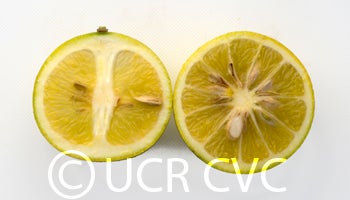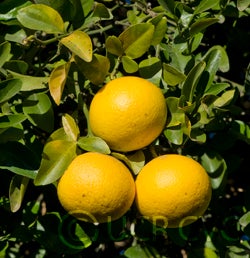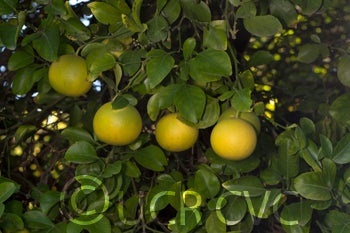X Citroncirus spp. RUTACEAE
CRC 3337
PI 539823
Source
Received as budwood from Albert Newcomb Ranch, Thermal, Calif., 1962.
Parentage/origins
Poncirus trifoliata x Citrus paradisi (unknown cultivars)
Rootstocks of accession
Carrizo citrange
Season of ripeness at Riverside
Unknown.
Notes and observations
Citrumelos are very similar to citranges. At least one of them, the Sacaton, produces large numbers of seeds containing only nucellar embryos and consequently yields identical F1 seedlings in great numbers, like the Troyer citrange...The Sacaton is a promising rootstock. (Swingle and Reece, 1967, p 347)
Dr J Furr's cross, USDCS, Indio. Budwood from J Carpenter's Phytophthora studies. This Sacaton citrumelo is from the oldest tree at Tempe Field Station, Ariz. (EM Nauer (?), ca 1987)
This accession is very different from the other two [PI 539826 & PI 539827] listed as Sacaton citrumelo. This fruit is larger and rougher; about half of the fruits are seedless, the others range from 1 to 8 or 10 seeds each. (EM Nauer, 11/21/1988)
There are currently three accessions labelled as 'Sacaton' citrumelo, PI 539823, PI 539826, and PI 539827. These were all acquired by the University of California Citrus Experiment Station in 1962, apparently in an attempt to acquire a "correct" 'Sacaton' citrumelo. Contrary to the comment from Ed Nauer shown on PI 539823, the origin of 'Sacaton' is apparently USDA, Texas, or possibly Arizona. The record for inactive accession PI 150921 indicates that it was PI'ed in 1945 from seeds collected from the Experiment Station in Winterhaven, Texas, by WT Swingle. References in the US Date & Citrus Station, Indio, accession book refer to seeds collected in Texas by JR Furr, the actual location in Texas not being stated. Olson et al (1961) report 'Sacaton' present at the USDA citrus collection at Rio Farms, Monte Alto. The Rio Farms tree is stated to have been a seedling planted in 1953 originating in Texas. It is therefore probable that 'Sacaton' originated in Texas (Winter Haven Station) and was then planted at Rio Farms and later sent to the Date & Citrus Station. PI 539826 was received at the CES from Rio Farms and appears to be the best match for the description as it has larger fruit and is seedier than the other two accessions. Note: this tree no longer existed in the 1990's when the Rio Farms collection was observed by Heinz Wutscher and Robert Krueger and John Bash. However, 'Sacaton' might be from Arizona. Swingle was in charge of the citrus breeding program (actually all of CPB) during the time period in which Albert Newcomb suggests 'Sacaton' was developed and could have taken seeds from the Sacaton Station to Winter Haven when Sacaton was closed, PI'ing them only after they arrived in Texas. Better documentation of the origin of 'Sacaton' may be available but is not currently on file at NCGRCD. Note that the suggestion that 'Sacaton' citrumelo and 'Yuma' citrange are the same is supported by Bill Bitters and previous workers. Currently, there seems to be a distinction between the "true citrumelo" (PI 539826) and the smaller fruited 'Yuma' citrange. Some additional observations should be made, a "correct" 'Sacaton' decided upon, and the other two accessions inactivated. Alternatively, 'Sacaton' and 'Yuma' could be consolidated into one accession if original fruit and tree descriptions can be located. They are not currently known to be on file at either NCGRCD or the CVC. (RR Krueger, 08/08/2012)
Description from The Citrus Industry Vol. 1 (1967)
"Citrumelos are very similar to citranges. At least one of them, the Sacaton, produces large numbers of seeds containing only nucellar embryos and consequently yields identical F1 seedlings in great numbers, like the Troyer citrange (see Hodgson). The Sacaton is a promising rootstock."
Availability
Not commercially available in California.
USDA Germplasm Resources Information Network page for Sacaton citrumelo trifoliate hybrid (CRC 3337)



